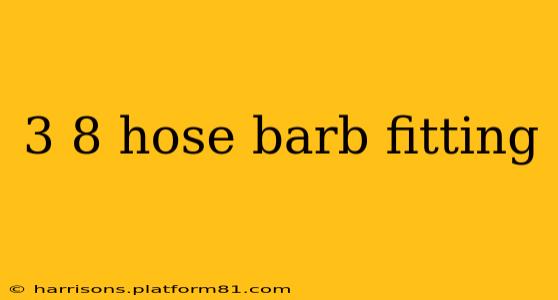Decoding the Mystery of 3/8" Hose Barb Fittings
Finding the right hose barb fitting can feel like navigating a maze of sizes and specifications. This comprehensive guide will help you understand 3/8" hose barb fittings, their applications, and how to choose the perfect one for your needs. We'll cover everything from the basics to more advanced considerations, ensuring you're equipped to make informed decisions for your project.
What is a 3/8" Hose Barb Fitting?
A 3/8" hose barb fitting is a connector used to securely attach a 3/8-inch inner diameter (ID) hose to another component, such as a pipe, valve, or other fitting. The "barb" refers to the small, outward-pointing protrusions on the fitting's interior. These barbs grip the hose when it's pushed onto the fitting, creating a leak-proof seal. The 3/8" refers to the inner diameter of the hose that the fitting is designed to accommodate.
What are the different types of 3/8" hose barb fittings?
There's a wide variety of 3/8" hose barb fittings available, each designed for specific applications and purposes. Some common types include:
- Straight Fittings: These offer a simple, inline connection.
- Elbow Fittings (90°): Used to change the direction of the hose by 90 degrees.
- Tee Fittings: Create a three-way connection, allowing you to branch off the main hose line.
- Union Fittings: Allow for easy disconnection of the hose without disturbing the rest of the system.
- Reducing Fittings: Connect hoses of different diameters, stepping down from a larger size to 3/8".
- Adapter Fittings: Facilitate connections between different types of fittings or components. For instance, a 3/8" hose barb to 1/4" NPT adapter.
What materials are 3/8" hose barb fittings made of?
The material of the fitting is crucial for its durability, chemical resistance, and suitability for the application. Common materials include:
- Brass: Offers excellent corrosion resistance and durability.
- Plastic (e.g., PVC, Nylon): Lighter, less expensive, and often suitable for lower-pressure applications. However, they may not be as durable or resistant to high temperatures as brass.
- Stainless Steel: Provides exceptional strength and corrosion resistance, making it ideal for demanding environments.
How do I choose the right 3/8" hose barb fitting for my project?
Selecting the correct fitting requires considering several factors:
- Hose Inner Diameter (ID): Ensure the fitting's ID matches your hose's ID.
- Fitting Material: Choose a material compatible with the fluid being used and the operating environment.
- Pressure Rating: Select a fitting with a pressure rating exceeding the maximum pressure in your system.
- Fitting Type: Choose the fitting type that best suits your piping configuration.
What are some common applications of 3/8" hose barb fittings?
3/8" hose barb fittings are versatile and find applications in a wide range of industries and DIY projects, including:
- Automotive: Fuel lines, coolant lines, brake lines.
- Industrial: Pneumatic systems, hydraulic systems, chemical transfer.
- Irrigation: Watering systems, drip irrigation lines.
- Aquariums: Water pumps, filters.
- DIY Projects: Home brewing, air compressors, water features.
Are there any safety considerations when using 3/8" hose barb fittings?
Always ensure that:
- Fittings are properly tightened: Over-tightening can damage the fitting or hose.
- Hose clamps are used where necessary: Clamps add extra security to prevent leaks, particularly under pressure.
- Fittings are compatible with the fluid: Use fittings made from materials that won't react with the fluid.
- The system is pressure-tested: Before using the system under pressure, test it thoroughly to ensure no leaks.
By understanding the various types, materials, and considerations involved in selecting a 3/8" hose barb fitting, you can ensure a safe, reliable, and efficient connection for your specific project. Remember to always prioritize safety and choose the right fitting for your application.
